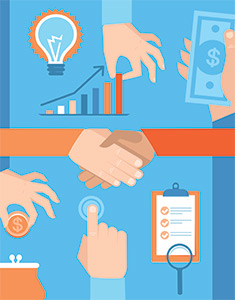Discounting is Slowly Killing Your Business
It’s the end of the quarter and sales have been sluggish. Desperate to up their take-home pay, your reps start cutting prices to incentivize customers to buy more or sooner than planned. Sound familiar?
A little back-and-forth on pricing is normal between salespeople and customers. When discounting goes unchecked and begins to pervade your company culture, however, it can quickly turn into an ugly monster that eventually destroys your business.
What’s wrong with discounting?
Using a small discount to create sales that otherwise wouldn’t happen sounds like a smart tactic, but in fact, it can quickly spiral into a serious problem.
1. It trades long-term profits for short-term sales spikes. Slashing prices might create a quick onslaught of sales but most salespeople, managers, and even owners don’t appreciate the negative impact it has on the business. According to McKinsey & Company, a 1% pricing discount results in a decrease of 8% in operating profits for the average company. On the flip side, if volumes remained stable, a price rise of 1% would generate an 8% increase in operating profits – an impact McKinsey reports is 50% greater than that of a 1 percent fall in variable costs such as materials or direct labor, and more than three times greater than the impact of a 1 percent increase in volume. Bottom-line, McKinsey’s studies support that a company’s strategy to cut prices in order to increase volumes and, as a result, raise profits is generally doomed to failure in almost every market and industry. That’s an incredibly powerful statement and not one that managers or companies can afford to ignore!
2. It turns you into a commodity. When word gets out that your sales team is quick to offer discounts, you’ll begin to attract customers that consider price as the primary reason they do business with you. When price is your unique selling proposition, you’re in a race to the bottom.
3. It sets a dangerous precedent. When your sales reps have free reign to cut prices, and do so on a regular basis to meet quotas or boost their commissions or bonuses, customers quickly learn to anticipate discounts. Once discounts are expected, they lose all value. It also becomes almost impossible to market around that and drive customer behavior or to get them to take advantage of company sponsored specials and other promotions. It is absolutely amazing that most managers and even owners, act as if the things that drive their own behavior as consumers, suddenly don’t apply to their business. Specifically, when was the last time you purchased an item from a retailer or business at the listed price when you knew from experience that firm had a history of running constant sales or discounting prices? So, how do you expect your own customer to react differently?
4. It can damage your brand. Nonstop price cutting can give your brand a bargain-basement feel. Customers will begin to think you don’t believe in the quality of your product or service, and soon they’ll see you as just the cheap alternative to higher-end competitors. It is wise to remember that customers won on price, are usually lost on price. By constantly discounting and cutting prices you’re sending your customers a pretty clear message that you don’t believe in or have confidence in your products or services. And, never forget, a lack of customer confidence in a product or company completely changes the game, and not in a good way.
How can you avoid the pitfalls of discounting?
To start using price cuts more intelligently, start by determining the reasons your sales team relies too heavily on discounts. Then, use these smart tactics to create change.
1. Evaluate your compensation and incentives plans. Rewarding your sales team based purely on volume is a sure way to encourage discounting. Instead, realign your plans to better reflect your company’s financial goals and its mission and values.
2. Put an end to unlimited discounting. If your team is allowed to discount at will, it’s time to take the reins and set limits. Require manager approval for all discounts, but realize that if your managers are incentivized in the same manner as your salesforce, they’re more than likely rubber stamping discounts or even worse, the most prevalent abusers. First and foremost, your entire team should be aligned to your goals. Frontline sales mangers, however, are more often than not on different plans than senior managers in many businesses. If that is the case in your business, make sure you elevate discount approval to an appropriate management level. In addition, there are things you can do like:
- Give your reps a certain amount of discount dollars each month or quarter, and allow them to use them however they want with their customers. When they burn through their allotment, however, that’s it.
- It’s shocking how many businesses allow their sales team to discount, yet still pay them their normal commission rate or bonuses. One of the simplest things you can do to begin reigning in discounting is to implement a sliding scale that reduces their commission or bonus once they discount. It’s amazing how fast discounting begins to taper once your team has skin in the game.
- Look at your discount history to see if you spot a pattern. Many companies or salespeople fall into a pattern of offering set discounts, as an example, 5% off. When you see patterns, it should tell you they’re not market driven, but rather bad habit driven. Like all bad habits, it’s hard to change overnight, so begin to challenge them in increments or by setting small goals. Ask, why 5%, could we have gotten the order at 4% or even 3% off? Remember, a 1% price improvement can translate into an 8% increase in operating profits.
3. Be more strategic with discounts. Too many businesses use pricing discounts haphazardly, but successful discounting must be strategic. Set goals for discounts (move dead inventory, attract new customers, retain loyal buyers, create buzz, etc.) and incorporate them strategically into your marketing plan. For example, use a discount on a new product as part of the overall launch strategy.
4. Help your reps reframe their messaging. When your salespeople believe in what they are selling, they are less likely to cave into customer demands for discounts. Provide comprehensive sales training that starts with an explanation of the value of your product or service. Show them how to strategically move their customers away from focusing on price and how to shift the conversation to value. Finally, give them sharper tools in their sales toolbox by educating them on effective sales and negotiation tactics. It’s also almost always money well spent to educate your salesforce on basic financials. In addition to helping them understand the pitfalls of discounting, it equips them to speak the language of executives at the firms they do business with.
Final Word
It’s not necessary to eliminate discounting entirely. It can serve as a useful role in building sales when it is done in a thoughtful and tactical manner. Frequent, haphazard discounting, on the other hand, can do more harm than good by tarnishing your image and by shredding profits. Remember, pricing discipline is the fastest and most effective way for managers to increase company profits.
About the Author
 Michael Schaffer is a senior executive with Tacony Corporation’s Commercial Floor Care (CFC) Division. He also serves as president of Tornado Industries®, a carpet and floor-care equipment manufacturer based in Chicago, IL as well as president of CFR, which designs and sells innovative carpet care equipment. Michael is an executive board member of the American Association of Cleaning Equipment Manufacturers (AACEM) and chairs AACEM’s Governance Committee. He has sat on a number of industry committees, including ISSA’s Cleaning Industry Training Standards (CITS), and has written extensively on general business topics as well as industry specific issues such as sustainability, water shortages, and green cleaning. Michael is a well-respected, authoritative source and public speaker on general business topics from motivation, sales, and change management, as well as industry related matters.
Michael Schaffer is a senior executive with Tacony Corporation’s Commercial Floor Care (CFC) Division. He also serves as president of Tornado Industries®, a carpet and floor-care equipment manufacturer based in Chicago, IL as well as president of CFR, which designs and sells innovative carpet care equipment. Michael is an executive board member of the American Association of Cleaning Equipment Manufacturers (AACEM) and chairs AACEM’s Governance Committee. He has sat on a number of industry committees, including ISSA’s Cleaning Industry Training Standards (CITS), and has written extensively on general business topics as well as industry specific issues such as sustainability, water shortages, and green cleaning. Michael is a well-respected, authoritative source and public speaker on general business topics from motivation, sales, and change management, as well as industry related matters.
10 Ways to Wow Your Clients

In the crowded BSC marketplace, it’s not enough to just deliver on the specs of an RFP and walk away.
Wow your clients without dropping prices

